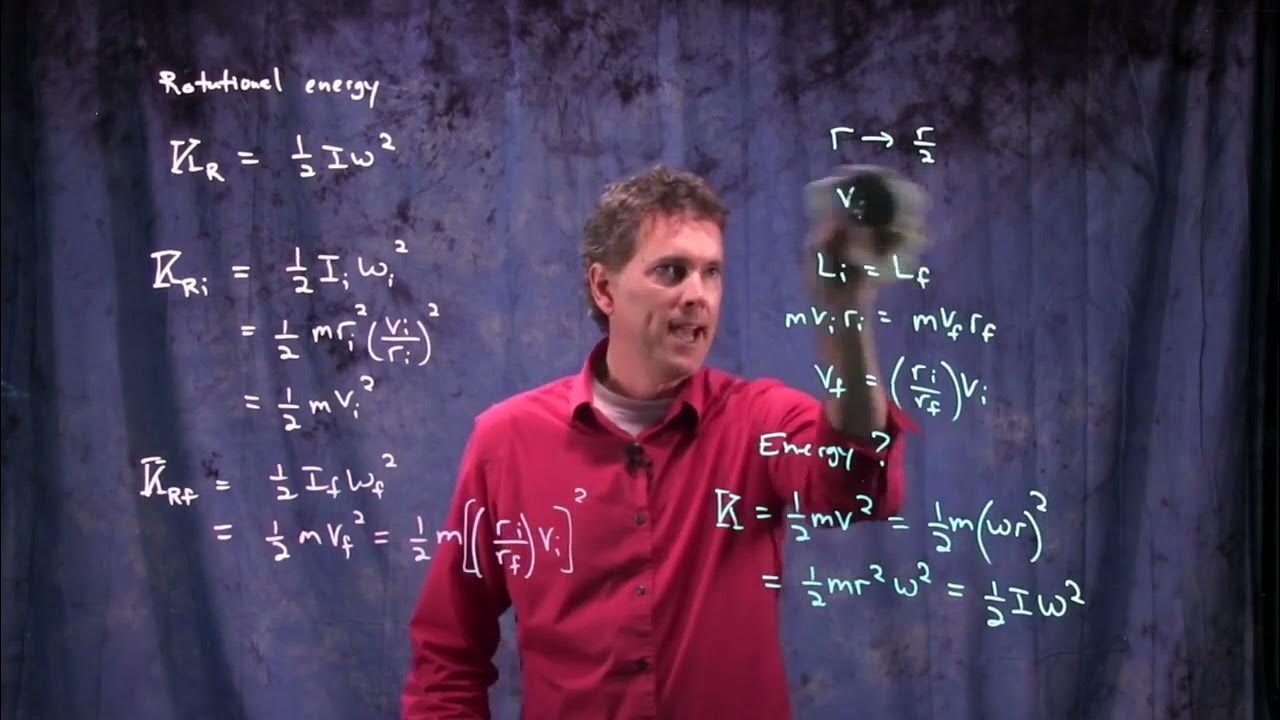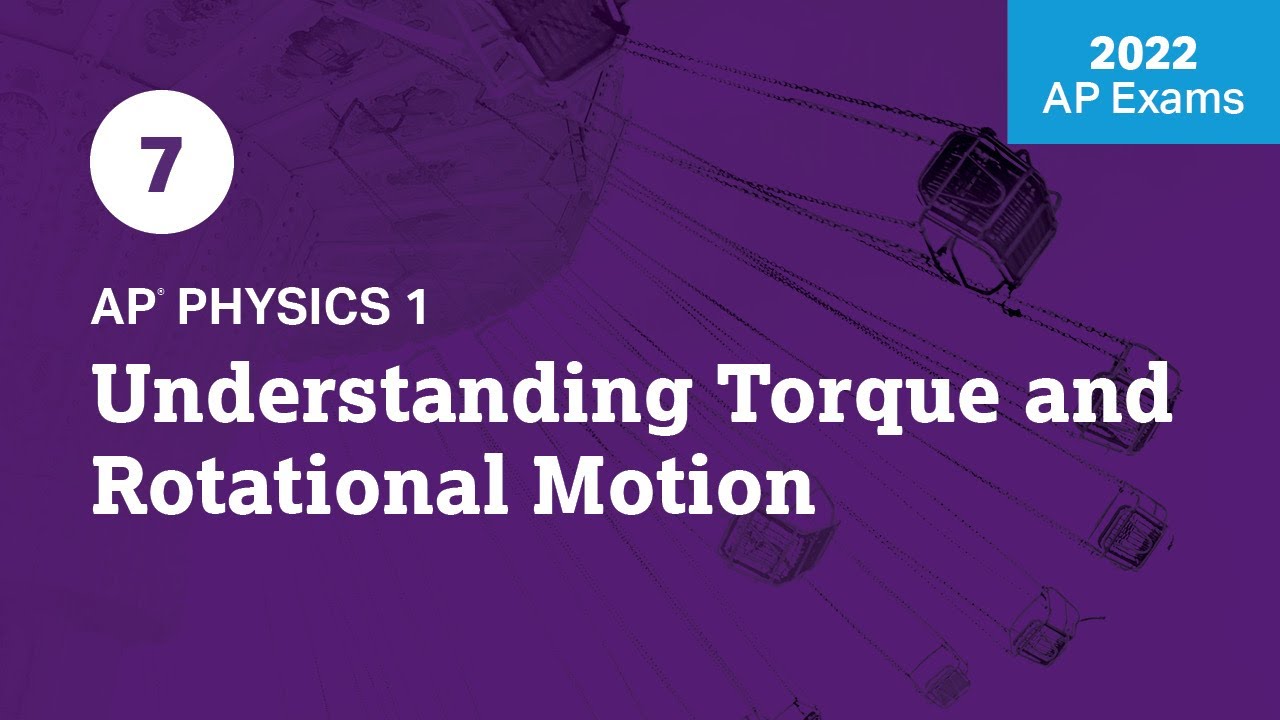Rotation Free Response Paragraph Questions (AP Physics 1)
TLDRIn this educational video, the host delves into the physics of a diver's rotation, explaining the principles of torque, angular momentum, and moment of inertia. They illustrate how a diver's angular speed increases when transitioning from a stretched position to a tucked position, using the conservation of angular momentum to demonstrate the relationship between moment of inertia and rotational speed. The video also touches on the concept of rotational kinetic energy, showing how it changes with the diver's posture, providing valuable insights for students preparing for exams.
Takeaways
- 🤿 The script discusses a diver's rotation in the air, relating to physical concepts of torque, angular momentum, and rotational kinetic energy.
- 🏊♂️ It emphasizes the importance of the initial force applied to the platform to initiate the spin, and the absence of external forces to maintain it.
- 🔄 The conservation of angular momentum (L) is highlighted, with the understanding that L = I Ω, where I is the moment of inertia and Ω is the angular velocity.
- 🧘 The script explains how the diver's moment of inertia changes from a stretched-out position to a tucked position, affecting their rotational speed.
- 📉 As the diver tucks, the moment of inertia decreases, leading to an increase in angular velocity (Ω) due to the conservation of angular momentum.
- 📈 The increase in angular velocity when tucking corresponds to an increase in rotational kinetic energy, as kinetic energy is proportional to the square of the angular velocity.
- 🔄 The opposite effect occurs when the diver extends from the tucked position, increasing the moment of inertia and decreasing the angular velocity.
- 🌐 The concept of moment of inertia is related to the distribution of mass relative to the axis of rotation, with a smaller radius leading to a lower moment of inertia.
- 🏋️♀️ The script compares the diver's motion to that of a figure skater, illustrating the principle of moment of inertia and its effect on rotational speed.
- 📚 The explanation is aimed at helping students understand the relationship between physical variables in rotational motion for problem-solving in exams.
- 👍 The video encourages viewers to engage with the content by liking, sharing, and applying the knowledge to excel in their studies.
Q & A
What is the main topic discussed in the video script?
-The main topic discussed in the video script is the concept of rotation, specifically as it relates to a diver's movements and the physics behind them.
What are the three stages of the diver's rotation mentioned in the script?
-The three stages mentioned are the diver's initial jump off the platform, the tuck position in the air, and the final position before landing in the water.
Why is the force applied by the foot to the platform important in the context of the script?
-The force applied by the foot to the platform is important because it initially sets the diver spinning, creating the torque that will be analyzed throughout the dive.
What is the role of the gravitational force (FG) in the diver's rotation?
-The gravitational force (FG) does not contribute to the diver's rotation; it only causes the diver to accelerate downwards towards the water, affecting linear speed, not rotational speed.
How does the conservation of angular momentum (L) relate to the diver's rotation?
-The conservation of angular momentum (L) implies that throughout the dive, L remains constant because there are no external torques acting on the diver to change their rate of spin.
What is the relationship between moment of inertia (I) and angular speed (Ω)?
-The relationship between moment of inertia (I) and angular speed (Ω) is given by L = I * Ω. If the moment of inertia decreases, the angular speed must increase, assuming angular momentum is conserved.
Why does the diver's speed increase when they transition from a stretched-out position to a tuck position?
-The diver's speed increases because, when they tuck, the distribution of mass changes, reducing the moment of inertia (I). With a constant angular momentum, a decrease in I results in an increase in angular speed (Ω).
What happens to the diver's angular speed and moment of inertia when they transition from the tuck position to a more extended position before landing?
-When the diver extends their body before landing, the distribution of mass increases, leading to an increase in moment of inertia (I). With a constant angular momentum, an increase in I results in a decrease in angular speed (Ω).
How is the rotational kinetic energy (KE) of the diver related to their angular speed and moment of inertia?
-The rotational kinetic energy (KE) of the diver is given by 0.5 * I * Ω^2. As the angular speed (Ω) increases or decreases, the rotational kinetic energy changes accordingly, assuming the moment of inertia (I) remains constant.
Why is the diver's rotational kinetic energy greater in the tuck position than in the stretched-out position?
-The diver's rotational kinetic energy is greater in the tuck position because, with a lower moment of inertia and a higher angular speed due to conservation of angular momentum, the KE formula results in a higher value.
What is the significance of understanding these physics concepts in analyzing the diver's movements?
-Understanding these physics concepts allows for a deeper analysis of the diver's movements, predicting changes in speed and rotation, and can be applied to other problems involving rotational dynamics.
Outlines
🤿 Diving Dynamics and Rotational Physics
This paragraph discusses a physics problem involving a diver who performs rotations after jumping off a platform. The focus is on understanding the forces and principles of rotation, particularly torque, moment of inertia, angular momentum, and how these relate to the diver's change in speed during the dive. The speaker emphasizes the importance of listing variables involved in rotation and explains that gravitational force does not contribute to rotational speed but affects linear motion. The conservation of angular momentum (L) is highlighted, and it's shown how a decrease in moment of inertia (I) leads to an increase in angular speed (Ω) when transitioning from a stretched to a tucked position.
🏒 Angular Momentum and Kinetic Energy in Figure Skating and Diving
The second paragraph extends the discussion to the relationship between angular momentum, moment of inertia, and kinetic energy in rotational motion, using the example of a figure skater and the diver. It explains how reducing the moment of inertia by tucking in (decreasing the radius, R) results in an increase in angular speed, and conversely, extending the body increases the radius and decreases the speed. The paragraph also connects these concepts to the rotational kinetic energy formula, demonstrating that an increase in speed when angular momentum is conserved leads to higher kinetic energy. The summary concludes with the application of these principles to compare the kinetic energy of the diver in different positions, indicating that the tucked position (figure 2) has greater kinetic energy than the initial stretched position (figure 1).
Mindmap
Keywords
💡Rotation
💡Torque
💡Angular Momentum
💡Moment of Inertia
💡Linear Kinematics
💡Conservation of Angular Momentum
💡Tuck Position
💡Kinetic Energy
💡Stretched Position
💡Diver's Performance
Highlights
Introduction to the topic of rotation with a focus on a diver's performance.
The importance of understanding the forces that cause rotation, specifically torque forces.
Explanation of how a diver's spin begins after leaving the platform without external forces.
The concept that gravitational force does not contribute to rotational speed.
Introduction of angular momentum (I Omega) and its role in the diver's rotation.
The relationship between moment of inertia and angular speed in rotation.
How a decrease in moment of inertia leads to an increase in angular speed.
The analogy of a figure skater to explain the change in moment of inertia.
The conservation of angular momentum (L) throughout the dive.
The impact of the diver's body position on the distribution of mass and moment of inertia.
The increase in angular speed as the diver transitions from a stretched to a tuck position.
The inverse relationship between moment of inertia and angular speed in the diver's rotation.
The explanation of how the diver's speed decreases when transitioning from a tuck to an extended position.
The application of the conservation of angular momentum to the diver's kinetic energy.
The formula for rotational kinetic energy and its relation to angular momentum.
The comparison of the diver's kinetic energy in different positions and its correlation with speed.
A summary of the key relationships and concepts needed to solve the problem.
The practical application of these concepts in understanding the diver's rotational dynamics.
Encouragement for viewers to apply the discussed concepts to other problems and real-world scenarios.
Transcripts
Browse More Related Video

Conservation of Angular Momentum

Rotational Energy | Physics with Professor Matt Anderson | M12-17

10. Rotations, Part II: Parallel Axis Theorem

2022 Live Review 7 | AP Physics 1 | Understanding Torque and Rotational Motion

AP Physics Workbook 7.I Collisions "Old and Lack Full Explanation"

AP Physics 1 review of Torque and Angular momentum | Physics | Khan Academy
5.0 / 5 (0 votes)
Thanks for rating: